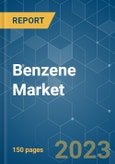The market was moderately impacted by COVID-19 in 2020. Temporary halts in the automotive manufacturing units minimized the demand for products like nylon tires, foam seating, and paints, which are made from benzene-derived intermediates like nylon, styrene, and phenol resins, thus negatively impacting market demand. However, the sector has been recovering well since restrictions were lifted. The demand for drugs like paracetamol, which consumes benzene-derived intermediates such as chlorobenzene, has increased, thus stimulating market demand in the pharmaceutical sector. Furthermore, the usage of packaging made up of polystyrene, an intermediate derived from benzene, has increased in food and e-commerce applications, which, in turn, has boosted the market demand for benzene.
Key Highlights
- The increasing demand for styrene polymers from various end-user industries, such as textile, packaging, and building and construction, is expected to drive the market's growth.
- Detrimental effects of benzene exposure may hinder the market's growth.
- In the coming years, the market may have more chances to make money if the demand for bio-based benzene keeps going up.
Benzene Market Trends
Increasing Demand for Ethylbenzene
- Ethylbenzene is a highly flammable, colorless liquid with an aromatic odor. It is primarily used to manufacture styrene.
- Styrene is used to make things like polystyrene, acrylonitrile-butadiene-styrene (ABS), styrene-acrylonitrile (SAN) resins, styrene-butadiene elastomers, latexes, and unsaturated polyester resins.
- Styrene polymers are used in many things, like TVs, IT equipment, one-time use medical products (like test kits), consumer electronics, portable speakers, and the housing for cassette tapes.
- According to OEC, in September 2022, China's styrene polymer exports accounted for USD 73.9 million. Between September 2021 and September 2022, the exports of China's styrene polymers increased by USD 21.9 million (42.1%), from USD 52 million to USD 73.9 million.
- According to the World Bank, United States exported 97,729,500 kg of styrene polymers (expansible polystyrene) in primary forms worth USD 198.68 million.
- According to the Chemical and Petrochemicals Manufacturers Association of India (CPMAI), styrene imports in India stood at 799 kilotons in FY2020-21, and the consumption is likely to increase as per the rising demand in the country.
- The demand for styrene is continuously growing due to an increased demand for rubber tires in both countries. According to the National Bureau of Statistics of China, the country's tire production reached 807.47 million units in 2020. It is further expected to increase in the upcoming years.
- According to the World Bank, in 2021, the top exporters of styrene polymers were the Netherlands (USD 620,100.91K), Other Asia (USD 409,224.45K), Turkey (USD 291,832.22K), Belgium (USD 248,619.88K), and Greece (USD 248,471.97K).
- Besides styrene, ethylbenzene is also used as a solvent in fuels and as an intermediate for other chemical applications. These uses are likely to keep the demand for ethylbenzene high and help it grow, which will boost the benzene market in the coming years.
Asia-Pacific to Dominate the Market
- Asia-Pacific currently leads in benzene consumption, accounting for roughly half of global consumption.
- The region is also expected to be the fastest-growing market during the forecast period, with an increasing market for end-users like electronics and home appliances, packaging, and construction in China, India, and ASEAN countries.
- According to the World Bank, in 2021, South Korea exported USD 2,254,944.80 thousand of benzene, while India exported USD 1,674,461.73 thousand. Thailand ranked third among the largest exporters of benzene, with data revealing USD 591.33 million of benzene was exported by the country.
- Benzene is widely used to produce construction products like adhesives, paints, flooring, and fiberglass. According to the National Bureau of Statistics of China, in 2021, the country's construction output was valued at approximately CNY 29.31 trillion (USD 4.54 trillion), which is likely to boost the demand for benzene in the region.
- In 2021, China's private-sector Hengyi Petrochemical announced its plan to set up a naphtha cracker that will add 80,000 TPA of benzene capacity along with other products.
- Reliance Industries Limited is among the top players in the production of benzene in the region, with an annual production capacity of 1400 KT, which sustains the domestic demand in India and exports to various countries globally.
- Because of these things, the Asia-Pacific region is likely to need more benzene over the next few years.
Benzene Industry Overview
The benzene market is consolidated in nature. Some of the major players in the market (not in any particular order) include BASF SE, Chevron Phillips Chemical Company LLC, ExxonMobil Corporation, LG Chem, and Shell PLC.Additional Benefits:
- The market estimate (ME) sheet in Excel format
- 3 months of analyst support
This product will be delivered within 2 business days.
Table of Contents
Companies Mentioned (Partial List)
A selection of companies mentioned in this report includes, but is not limited to:
- BASF SE
- Braskem
- Chevron Phillips Chemical Company LLC
- China Petroleum & Chemical Corporation
- Eastman Chemical Company
- Exxon Mobil Corporation
- Flint Hills Resources
- Hengyi Industries Sdn Bhd
- INEOS
- LG Chem
- LyondellBasell Industries Holdings BV
- Marathon Petroleum Company
- Maruzen Petrochemical
- Mitsubishi Chemical Corporation
- Reliance Industries Limited
- Shell PLC
- SABIC
- SIBUR








